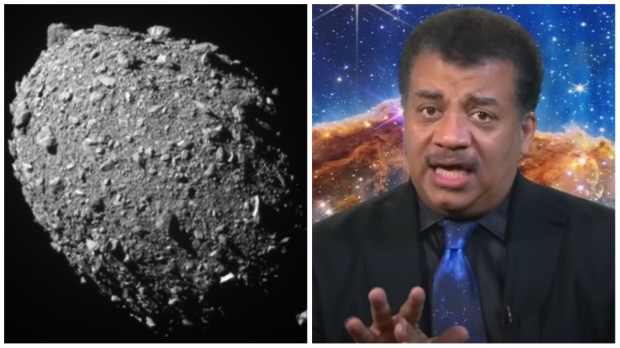NASA announced on September 27 that it had successfully collided a small spacecraft into a distant asteroid in the world's first planetary defense mission.
The success of the Double Asteroid Redirection Test (DART) marked the world's very first planetary defense mission, where the orbit of a planetary object was successfully altered, meaning Earth basically proved it has the capabilities of changing the orbit of distant objects. Famed astrophysicist and author Neil deGrasse Tyson appeared on PBS NewsHour to discuss the mission and the implications of its success.
Tyson said that humans have known about the risk of asteroids for many years and that he is surprised that a mission such as DART has taken so long to happen, considering the overall risks asteroids pose toward Earth. However, Tyson says, "better late than never", and went on to explain that the DART team selected a small 500-foot-wide asteroid that orbits a larger asteroid, hence its definition of a moonlet. The smaller asteroid named Dimorphos has a very well-understood orbit, and after the DART collision, astronomers are able to check how much of that orbit has changed based on the impact.
Tyson was asked why there was a preference to nudge the asteroid compared to blowing the entire space rock up, and he replied by saying that humans are historically good at blowing things up but aren't particularly good at knowing where all the pieces of that now-exploded object will go. Furthermore, Tyson says deflecting an asteroid has always been the much "wiser" option, as humans will get much better at deflecting "nothing will ever harm you" as you can just keep on deflecting objects without causing much smaller ones as an explosion would.
The astrophysicist goes on to explain that colliding the DART spacecraft with the moonlet in a head-on collision reduces its speed, and thus it falls to a lower orbit, reducing its total orbit time around its larger companion asteroid. NASA stated prior to launch that if Dimorphos' orbit is changed by 73 seconds or more, the mission would be an overall success. It was later announced that DART successfully reduced Dimorphos' orbit by 32 minutes, which means DART surpassed the minimum mission success requirement by a staggering 25 times.


